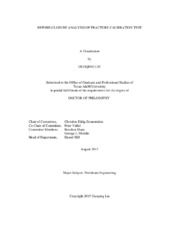| dc.description.abstract | Since injection falloff fracture calibration test is generally accepted as a reliable way to obtain several key formation parameters, it is one of the essential parts of hydraulic fracturing design. While several abnormal behaviors have been described qualitatively and are frequently observed in an injection falloff fracture calibration test, the only quantitative model for before-closure behavior accounts only for normal leakoff which usually seldom happens in practice. This paper describes several new analytical and semi-analytical models to simulate and quantify abnormal leakoff behaviors such as tip extension, pressure dependent leakoff (PDL), multiple apparent closures and transverse storage.
Based on material balance, we model pressure change with time considering the fracture geometry and leakoff volume under various leakoff mechanisms. Then, we show that the appearance of the modeled mechanisms both on the standard Nolte plot and on the log-log diagnostic Bourdet derivative presentation qualitatively matches behavior seen in previously published field data examples.
Results suggest that the early ½-slope occasionally observed on the log-log diagnostic plot is probably fracture linear flow. When present it can mask all or part of a wellbore storage effect. Natural fractures have a significant impact on the pressure falloff behavior when they are opened during treatment. Depending on the properties of the natural fracture system, the pressure response can behave as pressure-dependent leakoff (PDL), transverse storage, multiple closures or even normal leakoff in some cases. In addition, if tip extension or PDL behavior are observed, propagation pressure or natural fissures opening pressure can be estimated respectively.
The flow regime models are combined to provide a global model for the closure behavior. When shown on the log-log diagnostic plot, the various model features can be identified and used to estimate parameters to which each model is sensitive. Sensitivity analyses with the new model show relative importance with time of the various model features. This work promotes a complete understanding of the pressure response from various leakoff physics and provides a method to quantify parameters needed for more effective hydraulic fracture design. | en |


